Nursing Assignment: Homophobia, Inequality, and Health in Nursing
VerifiedAdded on 2020/04/07
|13
|3047
|1341
Essay
AI Summary
This nursing assignment delves into the crucial intersection of sociology and healthcare, examining how sociological principles enhance nursing practice and patient care. The essay explores the influence of sociology in understanding patient needs, promoting holistic care, and facilitating effective communication. It also investigates the relationship between health and human rights, emphasizing the importance of equitable access to healthcare and the impact of human rights violations on health outcomes. Furthermore, the assignment analyzes the effects of economic inequality on health, highlighting how socioeconomic status contributes to health disparities and unequal access to resources. Finally, it addresses the persistent issue of homophobia in healthcare, discussing its impact on patient care and the need for inclusive practices. Through detailed analysis and supporting references, the assignment provides a comprehensive overview of these critical issues in nursing, emphasizing their importance in promoting quality healthcare and addressing societal inequalities.
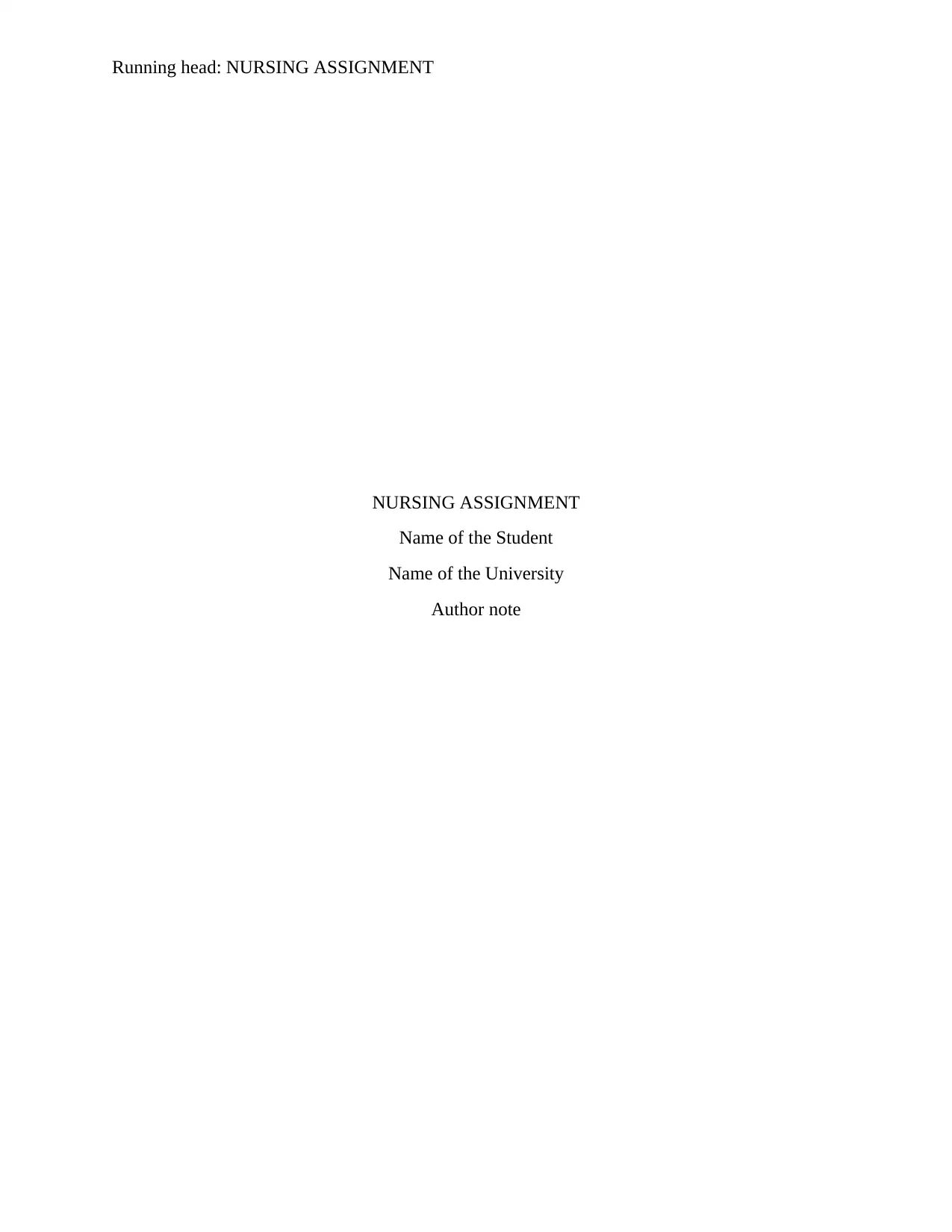
Running head: NURSING ASSIGNMENT
NURSING ASSIGNMENT
Name of the Student
Name of the University
Author note
NURSING ASSIGNMENT
Name of the Student
Name of the University
Author note
Paraphrase This Document
Need a fresh take? Get an instant paraphrase of this document with our AI Paraphraser
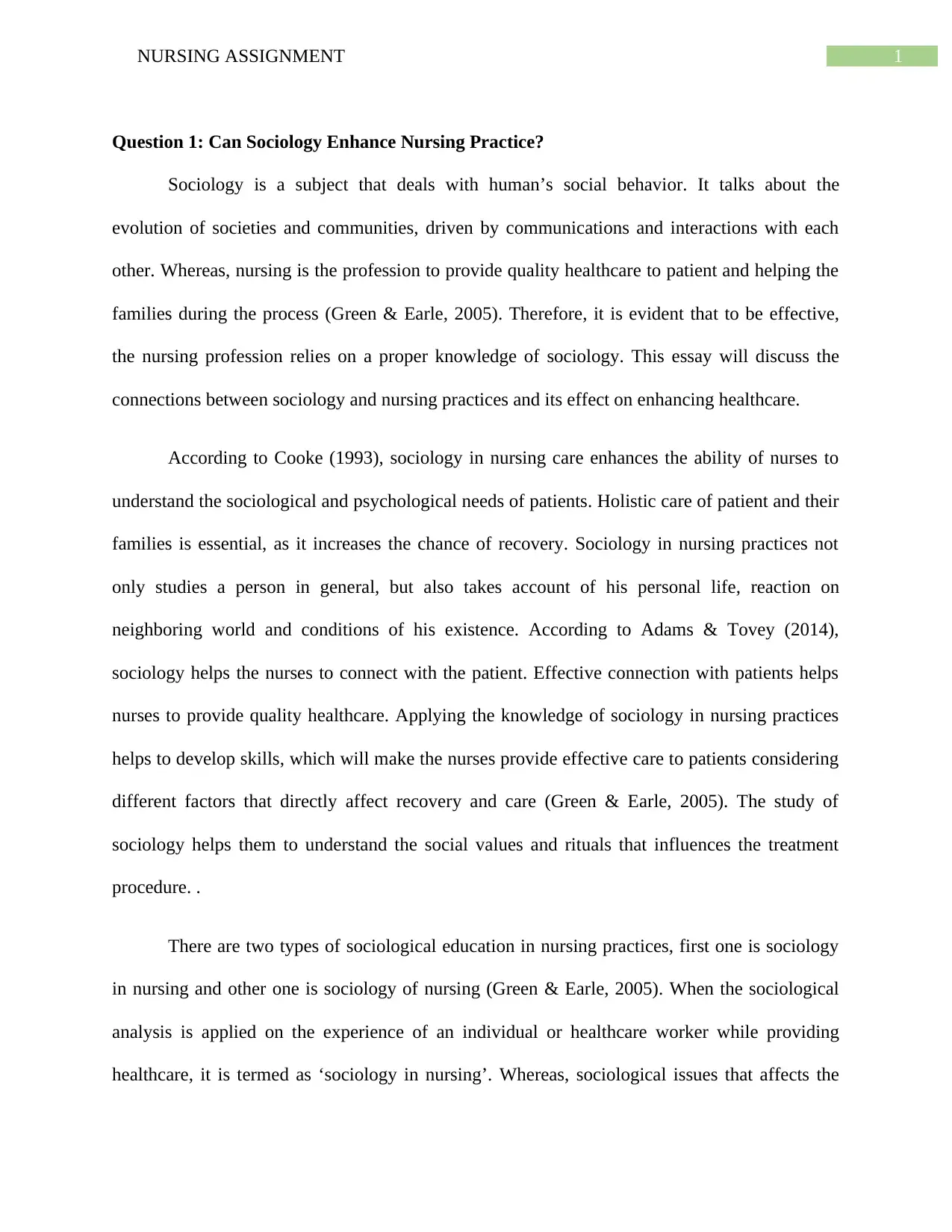
1NURSING ASSIGNMENT
Question 1: Can Sociology Enhance Nursing Practice?
Sociology is a subject that deals with human’s social behavior. It talks about the
evolution of societies and communities, driven by communications and interactions with each
other. Whereas, nursing is the profession to provide quality healthcare to patient and helping the
families during the process (Green & Earle, 2005). Therefore, it is evident that to be effective,
the nursing profession relies on a proper knowledge of sociology. This essay will discuss the
connections between sociology and nursing practices and its effect on enhancing healthcare.
According to Cooke (1993), sociology in nursing care enhances the ability of nurses to
understand the sociological and psychological needs of patients. Holistic care of patient and their
families is essential, as it increases the chance of recovery. Sociology in nursing practices not
only studies a person in general, but also takes account of his personal life, reaction on
neighboring world and conditions of his existence. According to Adams & Tovey (2014),
sociology helps the nurses to connect with the patient. Effective connection with patients helps
nurses to provide quality healthcare. Applying the knowledge of sociology in nursing practices
helps to develop skills, which will make the nurses provide effective care to patients considering
different factors that directly affect recovery and care (Green & Earle, 2005). The study of
sociology helps them to understand the social values and rituals that influences the treatment
procedure. .
There are two types of sociological education in nursing practices, first one is sociology
in nursing and other one is sociology of nursing (Green & Earle, 2005). When the sociological
analysis is applied on the experience of an individual or healthcare worker while providing
healthcare, it is termed as ‘sociology in nursing’. Whereas, sociological issues that affects the
Question 1: Can Sociology Enhance Nursing Practice?
Sociology is a subject that deals with human’s social behavior. It talks about the
evolution of societies and communities, driven by communications and interactions with each
other. Whereas, nursing is the profession to provide quality healthcare to patient and helping the
families during the process (Green & Earle, 2005). Therefore, it is evident that to be effective,
the nursing profession relies on a proper knowledge of sociology. This essay will discuss the
connections between sociology and nursing practices and its effect on enhancing healthcare.
According to Cooke (1993), sociology in nursing care enhances the ability of nurses to
understand the sociological and psychological needs of patients. Holistic care of patient and their
families is essential, as it increases the chance of recovery. Sociology in nursing practices not
only studies a person in general, but also takes account of his personal life, reaction on
neighboring world and conditions of his existence. According to Adams & Tovey (2014),
sociology helps the nurses to connect with the patient. Effective connection with patients helps
nurses to provide quality healthcare. Applying the knowledge of sociology in nursing practices
helps to develop skills, which will make the nurses provide effective care to patients considering
different factors that directly affect recovery and care (Green & Earle, 2005). The study of
sociology helps them to understand the social values and rituals that influences the treatment
procedure. .
There are two types of sociological education in nursing practices, first one is sociology
in nursing and other one is sociology of nursing (Green & Earle, 2005). When the sociological
analysis is applied on the experience of an individual or healthcare worker while providing
healthcare, it is termed as ‘sociology in nursing’. Whereas, sociological issues that affects the
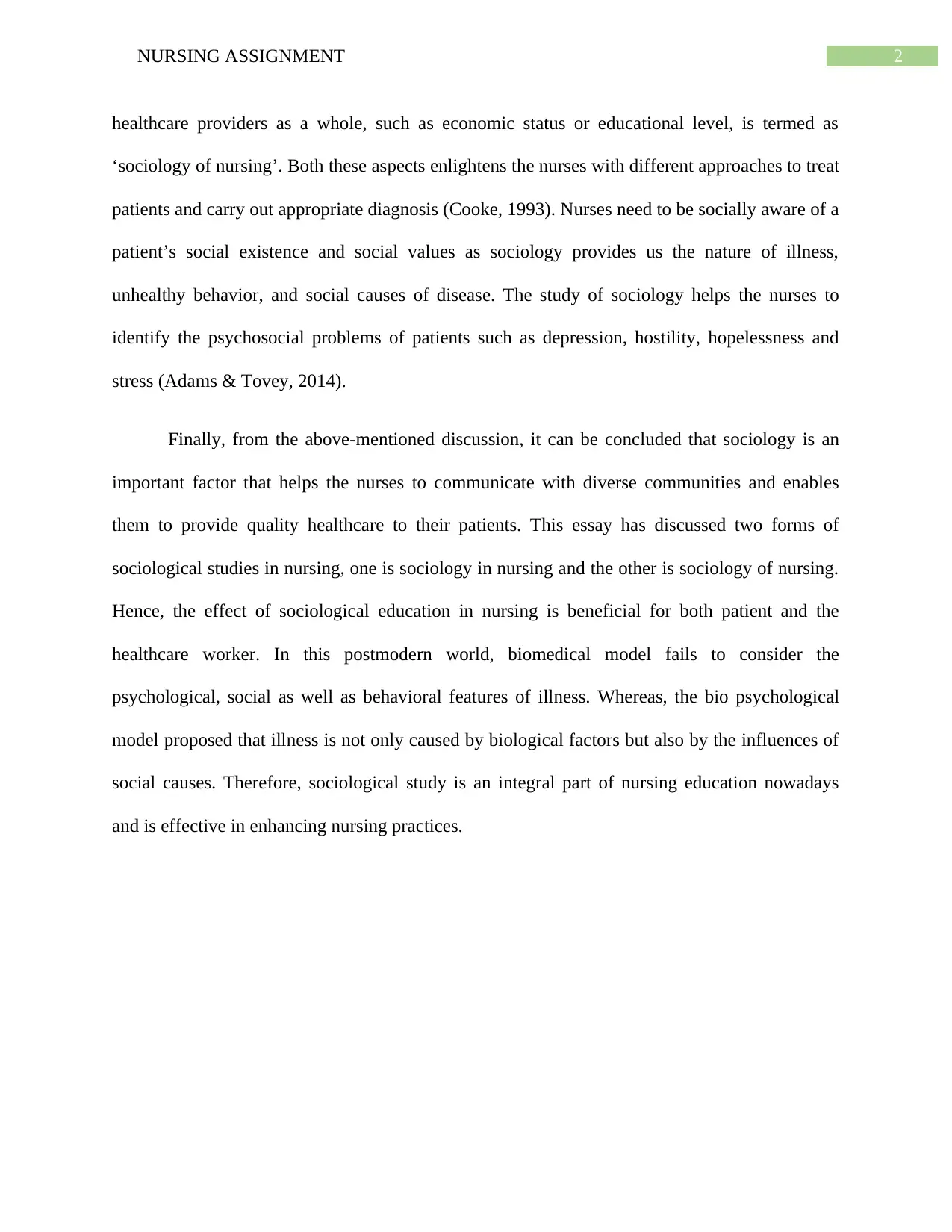
2NURSING ASSIGNMENT
healthcare providers as a whole, such as economic status or educational level, is termed as
‘sociology of nursing’. Both these aspects enlightens the nurses with different approaches to treat
patients and carry out appropriate diagnosis (Cooke, 1993). Nurses need to be socially aware of a
patient’s social existence and social values as sociology provides us the nature of illness,
unhealthy behavior, and social causes of disease. The study of sociology helps the nurses to
identify the psychosocial problems of patients such as depression, hostility, hopelessness and
stress (Adams & Tovey, 2014).
Finally, from the above-mentioned discussion, it can be concluded that sociology is an
important factor that helps the nurses to communicate with diverse communities and enables
them to provide quality healthcare to their patients. This essay has discussed two forms of
sociological studies in nursing, one is sociology in nursing and the other is sociology of nursing.
Hence, the effect of sociological education in nursing is beneficial for both patient and the
healthcare worker. In this postmodern world, biomedical model fails to consider the
psychological, social as well as behavioral features of illness. Whereas, the bio psychological
model proposed that illness is not only caused by biological factors but also by the influences of
social causes. Therefore, sociological study is an integral part of nursing education nowadays
and is effective in enhancing nursing practices.
healthcare providers as a whole, such as economic status or educational level, is termed as
‘sociology of nursing’. Both these aspects enlightens the nurses with different approaches to treat
patients and carry out appropriate diagnosis (Cooke, 1993). Nurses need to be socially aware of a
patient’s social existence and social values as sociology provides us the nature of illness,
unhealthy behavior, and social causes of disease. The study of sociology helps the nurses to
identify the psychosocial problems of patients such as depression, hostility, hopelessness and
stress (Adams & Tovey, 2014).
Finally, from the above-mentioned discussion, it can be concluded that sociology is an
important factor that helps the nurses to communicate with diverse communities and enables
them to provide quality healthcare to their patients. This essay has discussed two forms of
sociological studies in nursing, one is sociology in nursing and the other is sociology of nursing.
Hence, the effect of sociological education in nursing is beneficial for both patient and the
healthcare worker. In this postmodern world, biomedical model fails to consider the
psychological, social as well as behavioral features of illness. Whereas, the bio psychological
model proposed that illness is not only caused by biological factors but also by the influences of
social causes. Therefore, sociological study is an integral part of nursing education nowadays
and is effective in enhancing nursing practices.
⊘ This is a preview!⊘
Do you want full access?
Subscribe today to unlock all pages.

Trusted by 1+ million students worldwide
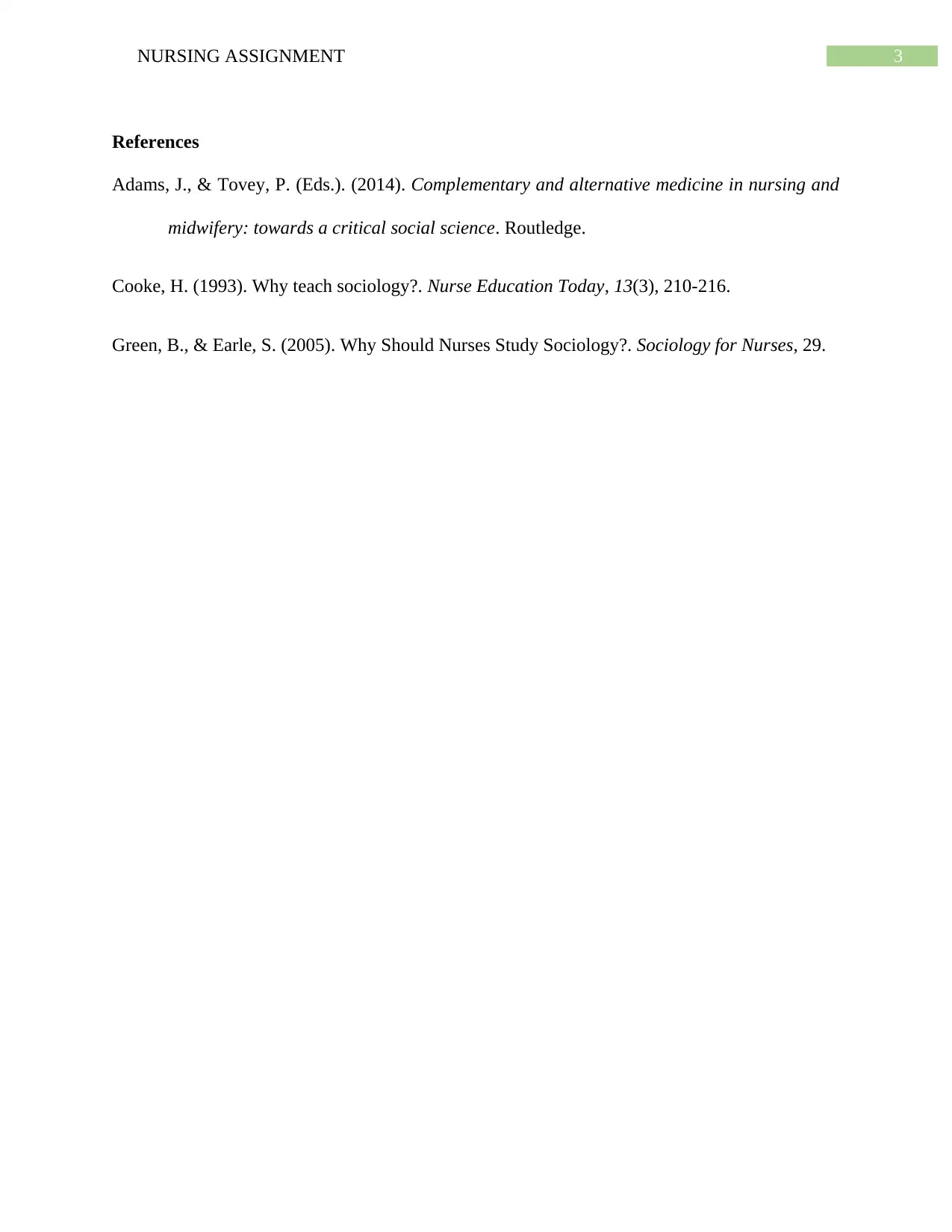
3NURSING ASSIGNMENT
References
Adams, J., & Tovey, P. (Eds.). (2014). Complementary and alternative medicine in nursing and
midwifery: towards a critical social science. Routledge.
Cooke, H. (1993). Why teach sociology?. Nurse Education Today, 13(3), 210-216.
Green, B., & Earle, S. (2005). Why Should Nurses Study Sociology?. Sociology for Nurses, 29.
References
Adams, J., & Tovey, P. (Eds.). (2014). Complementary and alternative medicine in nursing and
midwifery: towards a critical social science. Routledge.
Cooke, H. (1993). Why teach sociology?. Nurse Education Today, 13(3), 210-216.
Green, B., & Earle, S. (2005). Why Should Nurses Study Sociology?. Sociology for Nurses, 29.
Paraphrase This Document
Need a fresh take? Get an instant paraphrase of this document with our AI Paraphraser
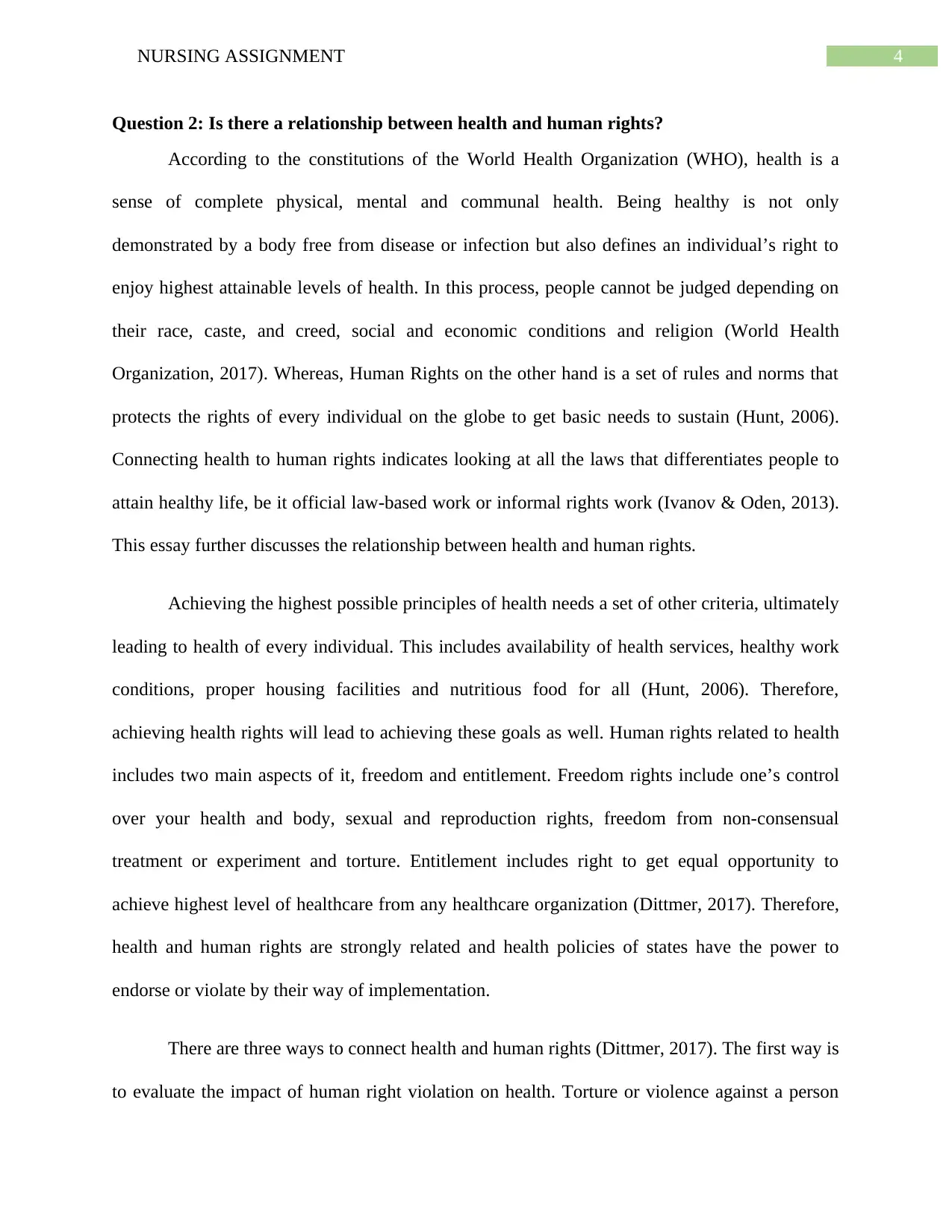
4NURSING ASSIGNMENT
Question 2: Is there a relationship between health and human rights?
According to the constitutions of the World Health Organization (WHO), health is a
sense of complete physical, mental and communal health. Being healthy is not only
demonstrated by a body free from disease or infection but also defines an individual’s right to
enjoy highest attainable levels of health. In this process, people cannot be judged depending on
their race, caste, and creed, social and economic conditions and religion (World Health
Organization, 2017). Whereas, Human Rights on the other hand is a set of rules and norms that
protects the rights of every individual on the globe to get basic needs to sustain (Hunt, 2006).
Connecting health to human rights indicates looking at all the laws that differentiates people to
attain healthy life, be it official law-based work or informal rights work (Ivanov & Oden, 2013).
This essay further discusses the relationship between health and human rights.
Achieving the highest possible principles of health needs a set of other criteria, ultimately
leading to health of every individual. This includes availability of health services, healthy work
conditions, proper housing facilities and nutritious food for all (Hunt, 2006). Therefore,
achieving health rights will lead to achieving these goals as well. Human rights related to health
includes two main aspects of it, freedom and entitlement. Freedom rights include one’s control
over your health and body, sexual and reproduction rights, freedom from non-consensual
treatment or experiment and torture. Entitlement includes right to get equal opportunity to
achieve highest level of healthcare from any healthcare organization (Dittmer, 2017). Therefore,
health and human rights are strongly related and health policies of states have the power to
endorse or violate by their way of implementation.
There are three ways to connect health and human rights (Dittmer, 2017). The first way is
to evaluate the impact of human right violation on health. Torture or violence against a person
Question 2: Is there a relationship between health and human rights?
According to the constitutions of the World Health Organization (WHO), health is a
sense of complete physical, mental and communal health. Being healthy is not only
demonstrated by a body free from disease or infection but also defines an individual’s right to
enjoy highest attainable levels of health. In this process, people cannot be judged depending on
their race, caste, and creed, social and economic conditions and religion (World Health
Organization, 2017). Whereas, Human Rights on the other hand is a set of rules and norms that
protects the rights of every individual on the globe to get basic needs to sustain (Hunt, 2006).
Connecting health to human rights indicates looking at all the laws that differentiates people to
attain healthy life, be it official law-based work or informal rights work (Ivanov & Oden, 2013).
This essay further discusses the relationship between health and human rights.
Achieving the highest possible principles of health needs a set of other criteria, ultimately
leading to health of every individual. This includes availability of health services, healthy work
conditions, proper housing facilities and nutritious food for all (Hunt, 2006). Therefore,
achieving health rights will lead to achieving these goals as well. Human rights related to health
includes two main aspects of it, freedom and entitlement. Freedom rights include one’s control
over your health and body, sexual and reproduction rights, freedom from non-consensual
treatment or experiment and torture. Entitlement includes right to get equal opportunity to
achieve highest level of healthcare from any healthcare organization (Dittmer, 2017). Therefore,
health and human rights are strongly related and health policies of states have the power to
endorse or violate by their way of implementation.
There are three ways to connect health and human rights (Dittmer, 2017). The first way is
to evaluate the impact of human right violation on health. Torture or violence against a person
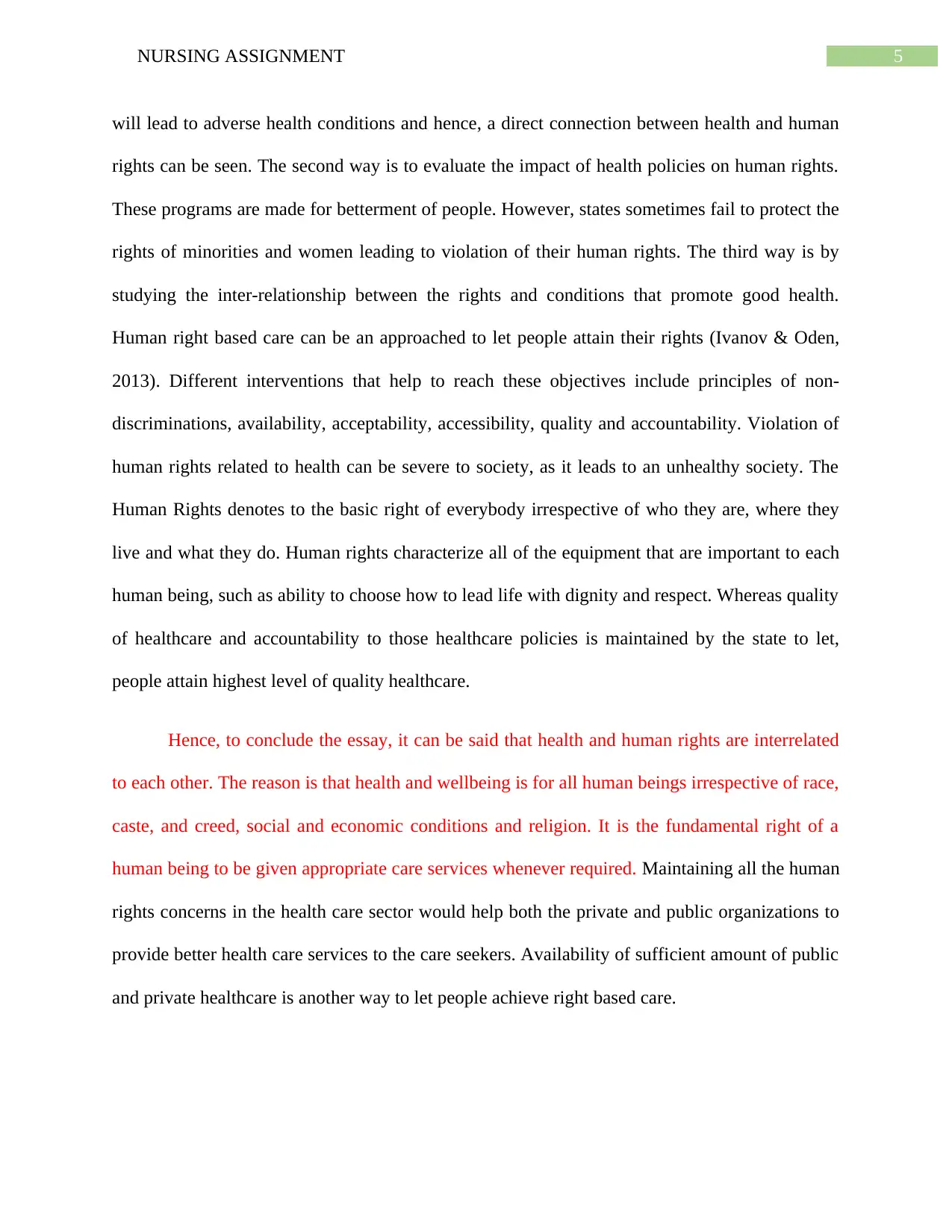
5NURSING ASSIGNMENT
will lead to adverse health conditions and hence, a direct connection between health and human
rights can be seen. The second way is to evaluate the impact of health policies on human rights.
These programs are made for betterment of people. However, states sometimes fail to protect the
rights of minorities and women leading to violation of their human rights. The third way is by
studying the inter-relationship between the rights and conditions that promote good health.
Human right based care can be an approached to let people attain their rights (Ivanov & Oden,
2013). Different interventions that help to reach these objectives include principles of non-
discriminations, availability, acceptability, accessibility, quality and accountability. Violation of
human rights related to health can be severe to society, as it leads to an unhealthy society. The
Human Rights denotes to the basic right of everybody irrespective of who they are, where they
live and what they do. Human rights characterize all of the equipment that are important to each
human being, such as ability to choose how to lead life with dignity and respect. Whereas quality
of healthcare and accountability to those healthcare policies is maintained by the state to let,
people attain highest level of quality healthcare.
Hence, to conclude the essay, it can be said that health and human rights are interrelated
to each other. The reason is that health and wellbeing is for all human beings irrespective of race,
caste, and creed, social and economic conditions and religion. It is the fundamental right of a
human being to be given appropriate care services whenever required. Maintaining all the human
rights concerns in the health care sector would help both the private and public organizations to
provide better health care services to the care seekers. Availability of sufficient amount of public
and private healthcare is another way to let people achieve right based care.
will lead to adverse health conditions and hence, a direct connection between health and human
rights can be seen. The second way is to evaluate the impact of health policies on human rights.
These programs are made for betterment of people. However, states sometimes fail to protect the
rights of minorities and women leading to violation of their human rights. The third way is by
studying the inter-relationship between the rights and conditions that promote good health.
Human right based care can be an approached to let people attain their rights (Ivanov & Oden,
2013). Different interventions that help to reach these objectives include principles of non-
discriminations, availability, acceptability, accessibility, quality and accountability. Violation of
human rights related to health can be severe to society, as it leads to an unhealthy society. The
Human Rights denotes to the basic right of everybody irrespective of who they are, where they
live and what they do. Human rights characterize all of the equipment that are important to each
human being, such as ability to choose how to lead life with dignity and respect. Whereas quality
of healthcare and accountability to those healthcare policies is maintained by the state to let,
people attain highest level of quality healthcare.
Hence, to conclude the essay, it can be said that health and human rights are interrelated
to each other. The reason is that health and wellbeing is for all human beings irrespective of race,
caste, and creed, social and economic conditions and religion. It is the fundamental right of a
human being to be given appropriate care services whenever required. Maintaining all the human
rights concerns in the health care sector would help both the private and public organizations to
provide better health care services to the care seekers. Availability of sufficient amount of public
and private healthcare is another way to let people achieve right based care.
⊘ This is a preview!⊘
Do you want full access?
Subscribe today to unlock all pages.

Trusted by 1+ million students worldwide
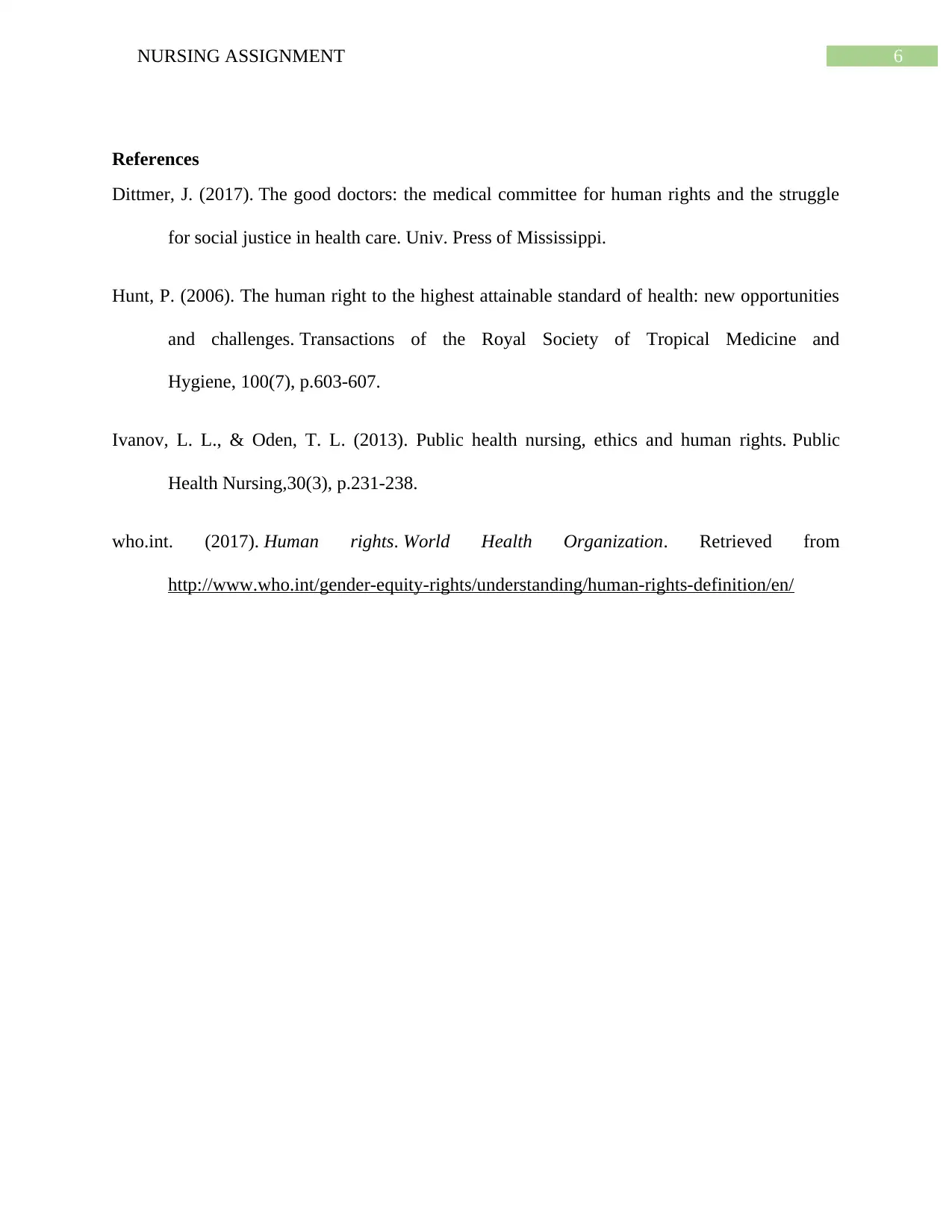
6NURSING ASSIGNMENT
References
Dittmer, J. (2017). The good doctors: the medical committee for human rights and the struggle
for social justice in health care. Univ. Press of Mississippi.
Hunt, P. (2006). The human right to the highest attainable standard of health: new opportunities
and challenges. Transactions of the Royal Society of Tropical Medicine and
Hygiene, 100(7), p.603-607.
Ivanov, L. L., & Oden, T. L. (2013). Public health nursing, ethics and human rights. Public
Health Nursing,30(3), p.231-238.
who.int. (2017). Human rights. World Health Organization. Retrieved from
http://www.who.int/gender-equity-rights/understanding/human-rights-definition/en/
References
Dittmer, J. (2017). The good doctors: the medical committee for human rights and the struggle
for social justice in health care. Univ. Press of Mississippi.
Hunt, P. (2006). The human right to the highest attainable standard of health: new opportunities
and challenges. Transactions of the Royal Society of Tropical Medicine and
Hygiene, 100(7), p.603-607.
Ivanov, L. L., & Oden, T. L. (2013). Public health nursing, ethics and human rights. Public
Health Nursing,30(3), p.231-238.
who.int. (2017). Human rights. World Health Organization. Retrieved from
http://www.who.int/gender-equity-rights/understanding/human-rights-definition/en/
Paraphrase This Document
Need a fresh take? Get an instant paraphrase of this document with our AI Paraphraser
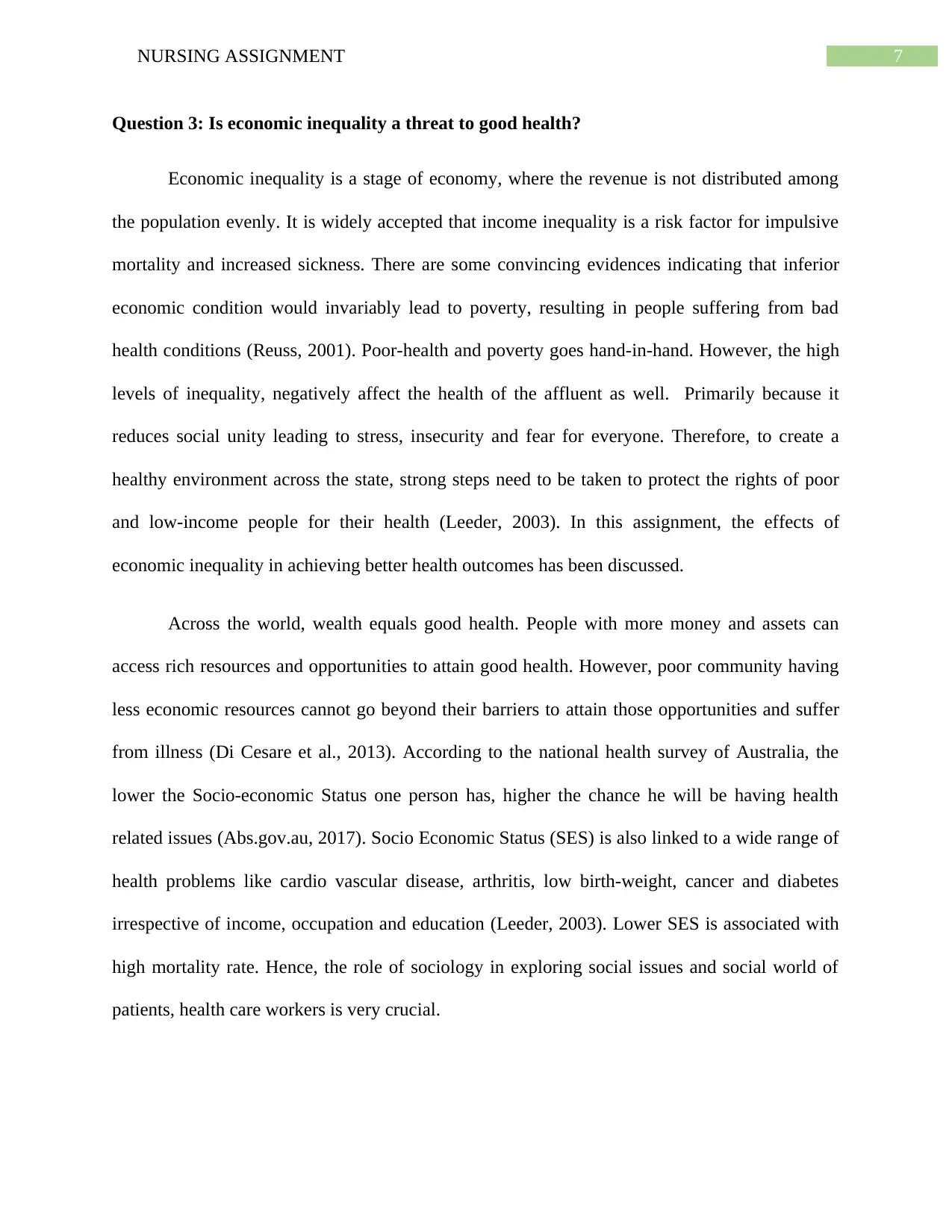
7NURSING ASSIGNMENT
Question 3: Is economic inequality a threat to good health?
Economic inequality is a stage of economy, where the revenue is not distributed among
the population evenly. It is widely accepted that income inequality is a risk factor for impulsive
mortality and increased sickness. There are some convincing evidences indicating that inferior
economic condition would invariably lead to poverty, resulting in people suffering from bad
health conditions (Reuss, 2001). Poor-health and poverty goes hand-in-hand. However, the high
levels of inequality, negatively affect the health of the affluent as well. Primarily because it
reduces social unity leading to stress, insecurity and fear for everyone. Therefore, to create a
healthy environment across the state, strong steps need to be taken to protect the rights of poor
and low-income people for their health (Leeder, 2003). In this assignment, the effects of
economic inequality in achieving better health outcomes has been discussed.
Across the world, wealth equals good health. People with more money and assets can
access rich resources and opportunities to attain good health. However, poor community having
less economic resources cannot go beyond their barriers to attain those opportunities and suffer
from illness (Di Cesare et al., 2013). According to the national health survey of Australia, the
lower the Socio-economic Status one person has, higher the chance he will be having health
related issues (Abs.gov.au, 2017). Socio Economic Status (SES) is also linked to a wide range of
health problems like cardio vascular disease, arthritis, low birth-weight, cancer and diabetes
irrespective of income, occupation and education (Leeder, 2003). Lower SES is associated with
high mortality rate. Hence, the role of sociology in exploring social issues and social world of
patients, health care workers is very crucial.
Question 3: Is economic inequality a threat to good health?
Economic inequality is a stage of economy, where the revenue is not distributed among
the population evenly. It is widely accepted that income inequality is a risk factor for impulsive
mortality and increased sickness. There are some convincing evidences indicating that inferior
economic condition would invariably lead to poverty, resulting in people suffering from bad
health conditions (Reuss, 2001). Poor-health and poverty goes hand-in-hand. However, the high
levels of inequality, negatively affect the health of the affluent as well. Primarily because it
reduces social unity leading to stress, insecurity and fear for everyone. Therefore, to create a
healthy environment across the state, strong steps need to be taken to protect the rights of poor
and low-income people for their health (Leeder, 2003). In this assignment, the effects of
economic inequality in achieving better health outcomes has been discussed.
Across the world, wealth equals good health. People with more money and assets can
access rich resources and opportunities to attain good health. However, poor community having
less economic resources cannot go beyond their barriers to attain those opportunities and suffer
from illness (Di Cesare et al., 2013). According to the national health survey of Australia, the
lower the Socio-economic Status one person has, higher the chance he will be having health
related issues (Abs.gov.au, 2017). Socio Economic Status (SES) is also linked to a wide range of
health problems like cardio vascular disease, arthritis, low birth-weight, cancer and diabetes
irrespective of income, occupation and education (Leeder, 2003). Lower SES is associated with
high mortality rate. Hence, the role of sociology in exploring social issues and social world of
patients, health care workers is very crucial.
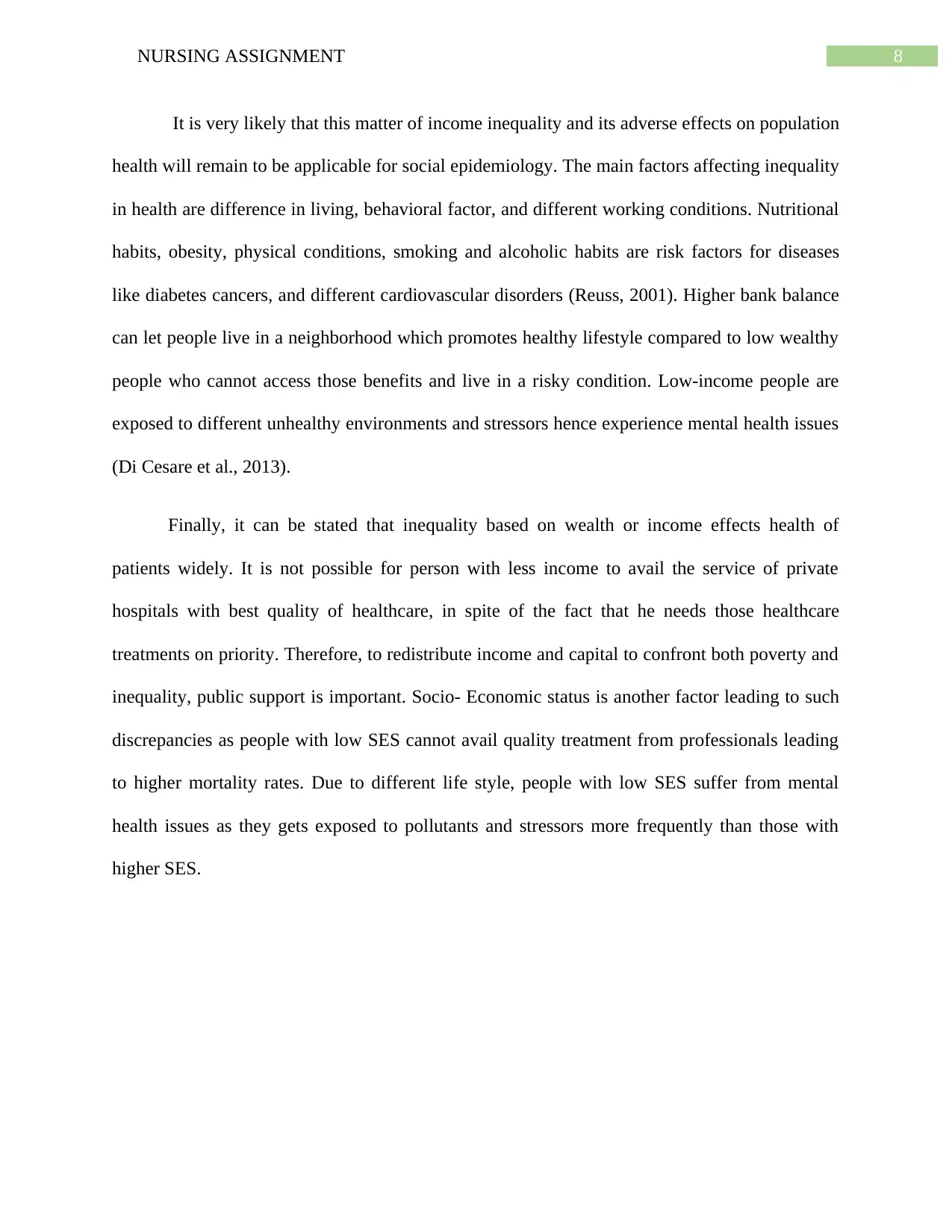
8NURSING ASSIGNMENT
It is very likely that this matter of income inequality and its adverse effects on population
health will remain to be applicable for social epidemiology. The main factors affecting inequality
in health are difference in living, behavioral factor, and different working conditions. Nutritional
habits, obesity, physical conditions, smoking and alcoholic habits are risk factors for diseases
like diabetes cancers, and different cardiovascular disorders (Reuss, 2001). Higher bank balance
can let people live in a neighborhood which promotes healthy lifestyle compared to low wealthy
people who cannot access those benefits and live in a risky condition. Low-income people are
exposed to different unhealthy environments and stressors hence experience mental health issues
(Di Cesare et al., 2013).
Finally, it can be stated that inequality based on wealth or income effects health of
patients widely. It is not possible for person with less income to avail the service of private
hospitals with best quality of healthcare, in spite of the fact that he needs those healthcare
treatments on priority. Therefore, to redistribute income and capital to confront both poverty and
inequality, public support is important. Socio- Economic status is another factor leading to such
discrepancies as people with low SES cannot avail quality treatment from professionals leading
to higher mortality rates. Due to different life style, people with low SES suffer from mental
health issues as they gets exposed to pollutants and stressors more frequently than those with
higher SES.
It is very likely that this matter of income inequality and its adverse effects on population
health will remain to be applicable for social epidemiology. The main factors affecting inequality
in health are difference in living, behavioral factor, and different working conditions. Nutritional
habits, obesity, physical conditions, smoking and alcoholic habits are risk factors for diseases
like diabetes cancers, and different cardiovascular disorders (Reuss, 2001). Higher bank balance
can let people live in a neighborhood which promotes healthy lifestyle compared to low wealthy
people who cannot access those benefits and live in a risky condition. Low-income people are
exposed to different unhealthy environments and stressors hence experience mental health issues
(Di Cesare et al., 2013).
Finally, it can be stated that inequality based on wealth or income effects health of
patients widely. It is not possible for person with less income to avail the service of private
hospitals with best quality of healthcare, in spite of the fact that he needs those healthcare
treatments on priority. Therefore, to redistribute income and capital to confront both poverty and
inequality, public support is important. Socio- Economic status is another factor leading to such
discrepancies as people with low SES cannot avail quality treatment from professionals leading
to higher mortality rates. Due to different life style, people with low SES suffer from mental
health issues as they gets exposed to pollutants and stressors more frequently than those with
higher SES.
⊘ This is a preview!⊘
Do you want full access?
Subscribe today to unlock all pages.

Trusted by 1+ million students worldwide
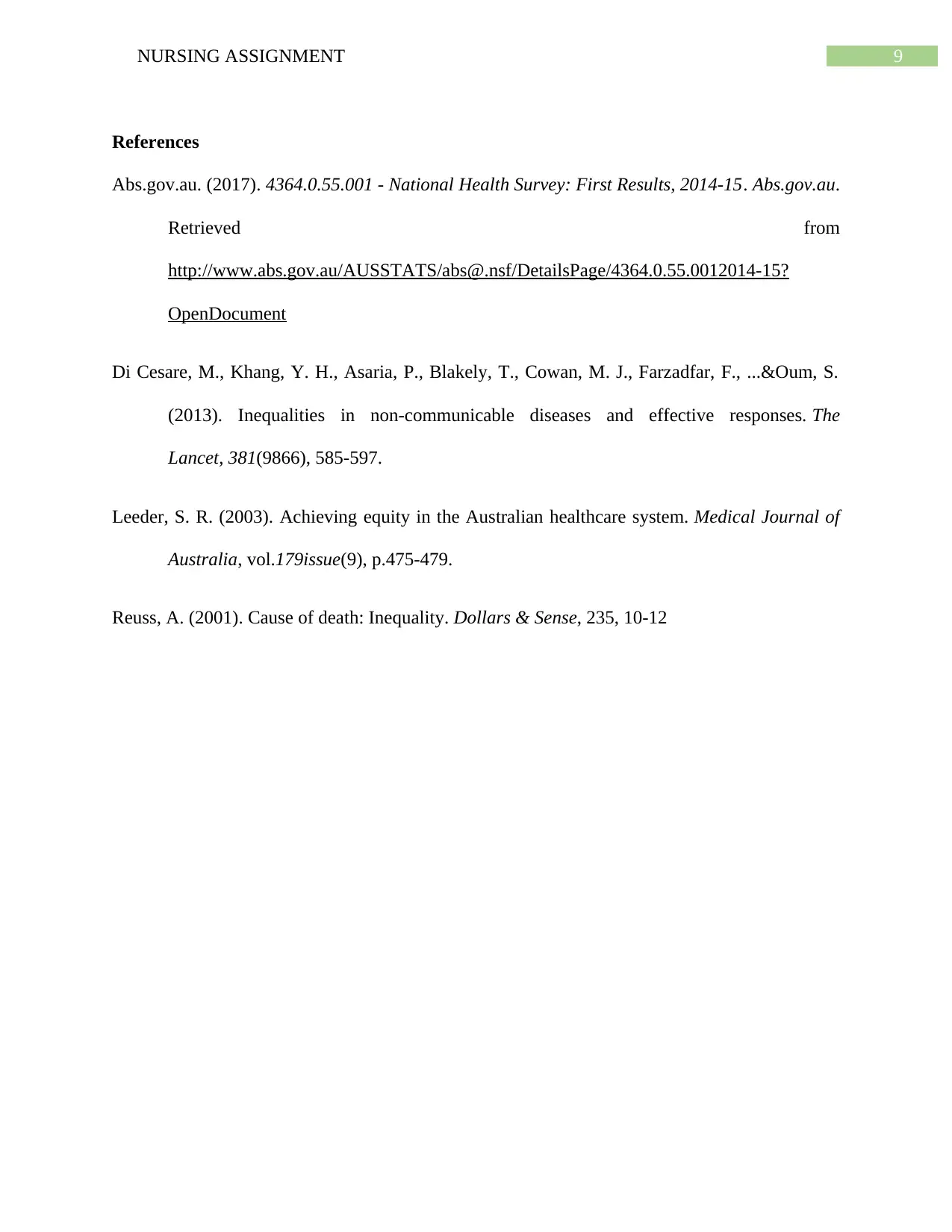
9NURSING ASSIGNMENT
References
Abs.gov.au. (2017). 4364.0.55.001 - National Health Survey: First Results, 2014-15. Abs.gov.au.
Retrieved from
http://www.abs.gov.au/AUSSTATS/abs@.nsf/DetailsPage/4364.0.55.0012014-15?
OpenDocument
Di Cesare, M., Khang, Y. H., Asaria, P., Blakely, T., Cowan, M. J., Farzadfar, F., ...&Oum, S.
(2013). Inequalities in non-communicable diseases and effective responses. The
Lancet, 381(9866), 585-597.
Leeder, S. R. (2003). Achieving equity in the Australian healthcare system. Medical Journal of
Australia, vol.179issue(9), p.475-479.
Reuss, A. (2001). Cause of death: Inequality. Dollars & Sense, 235, 10-12
References
Abs.gov.au. (2017). 4364.0.55.001 - National Health Survey: First Results, 2014-15. Abs.gov.au.
Retrieved from
http://www.abs.gov.au/AUSSTATS/abs@.nsf/DetailsPage/4364.0.55.0012014-15?
OpenDocument
Di Cesare, M., Khang, Y. H., Asaria, P., Blakely, T., Cowan, M. J., Farzadfar, F., ...&Oum, S.
(2013). Inequalities in non-communicable diseases and effective responses. The
Lancet, 381(9866), 585-597.
Leeder, S. R. (2003). Achieving equity in the Australian healthcare system. Medical Journal of
Australia, vol.179issue(9), p.475-479.
Reuss, A. (2001). Cause of death: Inequality. Dollars & Sense, 235, 10-12
Paraphrase This Document
Need a fresh take? Get an instant paraphrase of this document with our AI Paraphraser
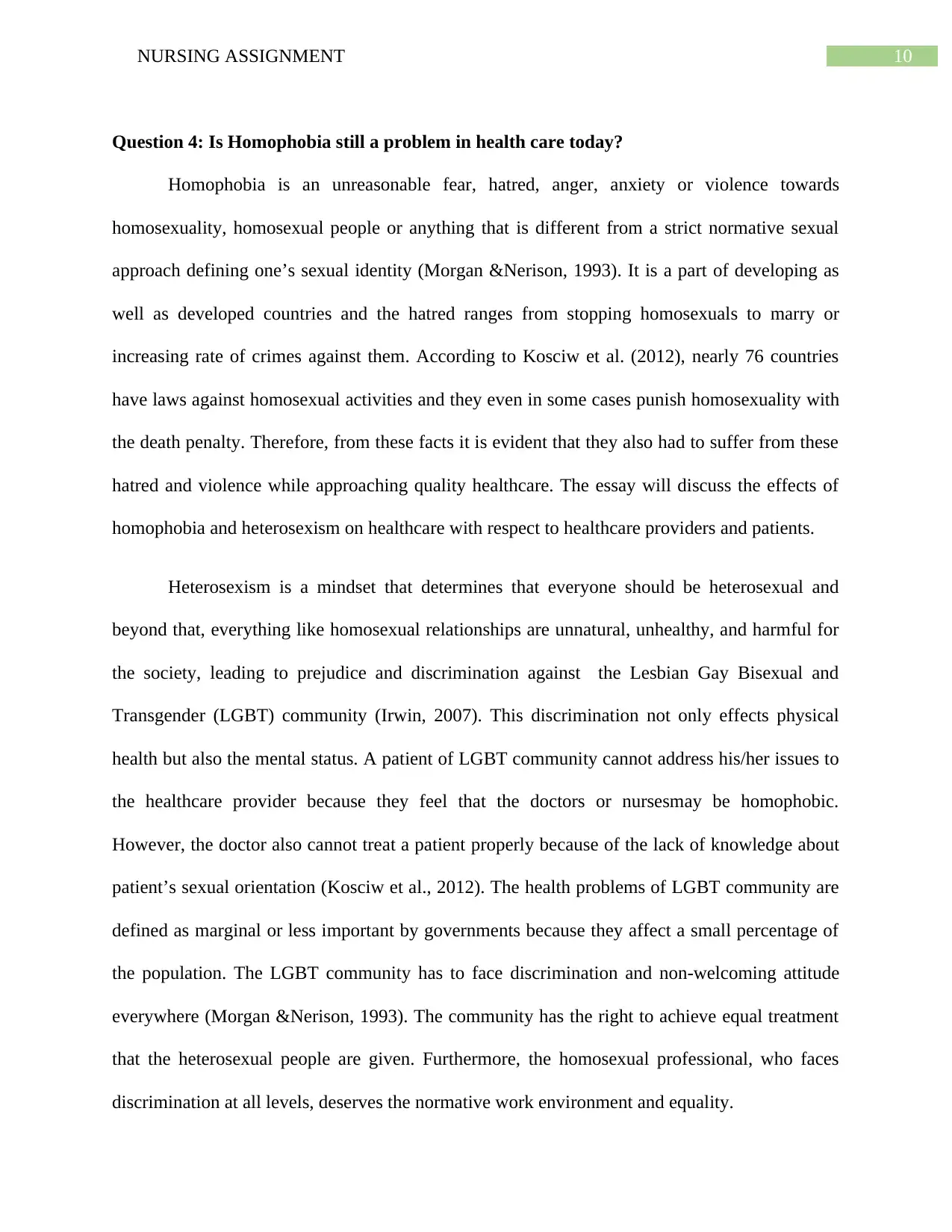
10NURSING ASSIGNMENT
Question 4: Is Homophobia still a problem in health care today?
Homophobia is an unreasonable fear, hatred, anger, anxiety or violence towards
homosexuality, homosexual people or anything that is different from a strict normative sexual
approach defining one’s sexual identity (Morgan &Nerison, 1993). It is a part of developing as
well as developed countries and the hatred ranges from stopping homosexuals to marry or
increasing rate of crimes against them. According to Kosciw et al. (2012), nearly 76 countries
have laws against homosexual activities and they even in some cases punish homosexuality with
the death penalty. Therefore, from these facts it is evident that they also had to suffer from these
hatred and violence while approaching quality healthcare. The essay will discuss the effects of
homophobia and heterosexism on healthcare with respect to healthcare providers and patients.
Heterosexism is a mindset that determines that everyone should be heterosexual and
beyond that, everything like homosexual relationships are unnatural, unhealthy, and harmful for
the society, leading to prejudice and discrimination against the Lesbian Gay Bisexual and
Transgender (LGBT) community (Irwin, 2007). This discrimination not only effects physical
health but also the mental status. A patient of LGBT community cannot address his/her issues to
the healthcare provider because they feel that the doctors or nursesmay be homophobic.
However, the doctor also cannot treat a patient properly because of the lack of knowledge about
patient’s sexual orientation (Kosciw et al., 2012). The health problems of LGBT community are
defined as marginal or less important by governments because they affect a small percentage of
the population. The LGBT community has to face discrimination and non-welcoming attitude
everywhere (Morgan &Nerison, 1993). The community has the right to achieve equal treatment
that the heterosexual people are given. Furthermore, the homosexual professional, who faces
discrimination at all levels, deserves the normative work environment and equality.
Question 4: Is Homophobia still a problem in health care today?
Homophobia is an unreasonable fear, hatred, anger, anxiety or violence towards
homosexuality, homosexual people or anything that is different from a strict normative sexual
approach defining one’s sexual identity (Morgan &Nerison, 1993). It is a part of developing as
well as developed countries and the hatred ranges from stopping homosexuals to marry or
increasing rate of crimes against them. According to Kosciw et al. (2012), nearly 76 countries
have laws against homosexual activities and they even in some cases punish homosexuality with
the death penalty. Therefore, from these facts it is evident that they also had to suffer from these
hatred and violence while approaching quality healthcare. The essay will discuss the effects of
homophobia and heterosexism on healthcare with respect to healthcare providers and patients.
Heterosexism is a mindset that determines that everyone should be heterosexual and
beyond that, everything like homosexual relationships are unnatural, unhealthy, and harmful for
the society, leading to prejudice and discrimination against the Lesbian Gay Bisexual and
Transgender (LGBT) community (Irwin, 2007). This discrimination not only effects physical
health but also the mental status. A patient of LGBT community cannot address his/her issues to
the healthcare provider because they feel that the doctors or nursesmay be homophobic.
However, the doctor also cannot treat a patient properly because of the lack of knowledge about
patient’s sexual orientation (Kosciw et al., 2012). The health problems of LGBT community are
defined as marginal or less important by governments because they affect a small percentage of
the population. The LGBT community has to face discrimination and non-welcoming attitude
everywhere (Morgan &Nerison, 1993). The community has the right to achieve equal treatment
that the heterosexual people are given. Furthermore, the homosexual professional, who faces
discrimination at all levels, deserves the normative work environment and equality.
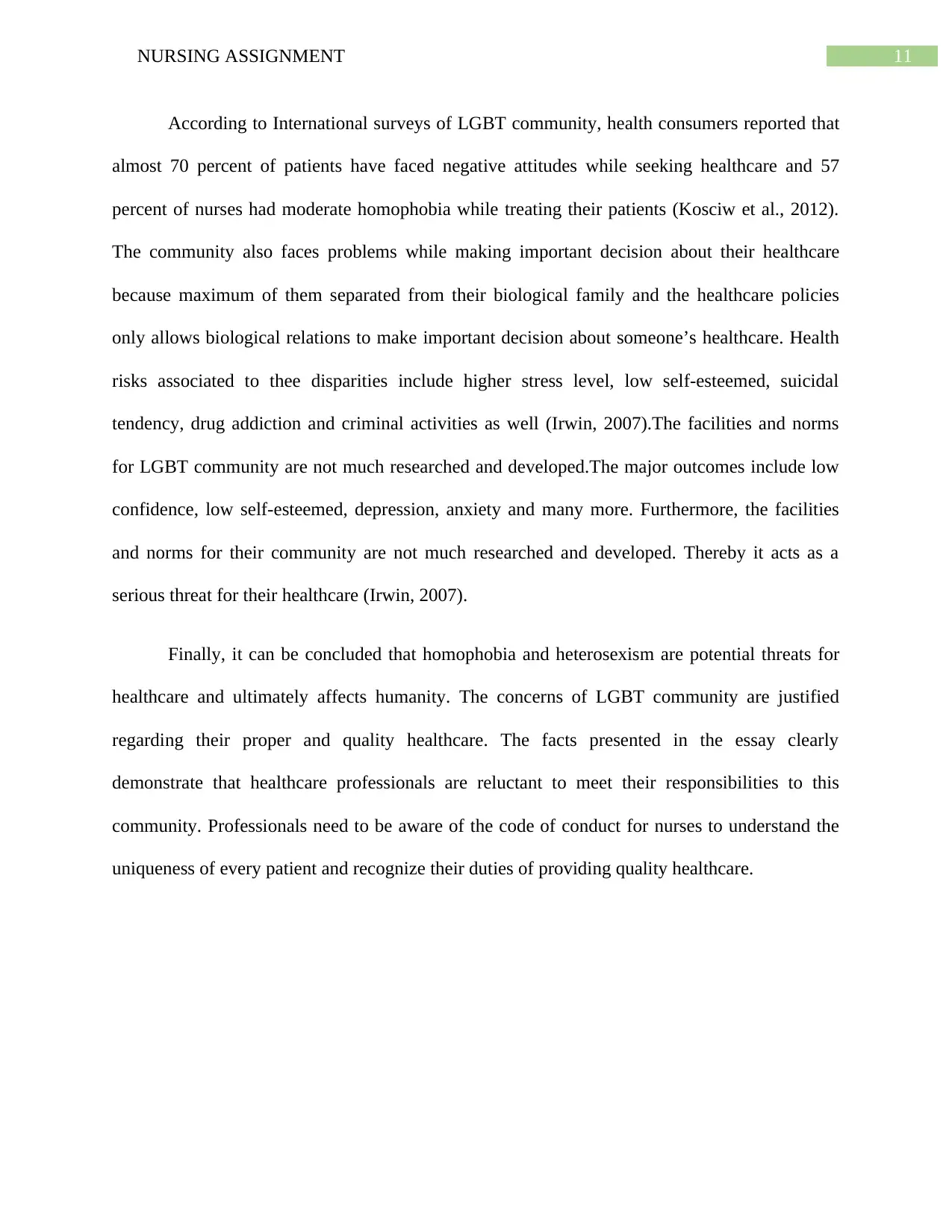
11NURSING ASSIGNMENT
According to International surveys of LGBT community, health consumers reported that
almost 70 percent of patients have faced negative attitudes while seeking healthcare and 57
percent of nurses had moderate homophobia while treating their patients (Kosciw et al., 2012).
The community also faces problems while making important decision about their healthcare
because maximum of them separated from their biological family and the healthcare policies
only allows biological relations to make important decision about someone’s healthcare. Health
risks associated to thee disparities include higher stress level, low self-esteemed, suicidal
tendency, drug addiction and criminal activities as well (Irwin, 2007).The facilities and norms
for LGBT community are not much researched and developed.The major outcomes include low
confidence, low self-esteemed, depression, anxiety and many more. Furthermore, the facilities
and norms for their community are not much researched and developed. Thereby it acts as a
serious threat for their healthcare (Irwin, 2007).
Finally, it can be concluded that homophobia and heterosexism are potential threats for
healthcare and ultimately affects humanity. The concerns of LGBT community are justified
regarding their proper and quality healthcare. The facts presented in the essay clearly
demonstrate that healthcare professionals are reluctant to meet their responsibilities to this
community. Professionals need to be aware of the code of conduct for nurses to understand the
uniqueness of every patient and recognize their duties of providing quality healthcare.
According to International surveys of LGBT community, health consumers reported that
almost 70 percent of patients have faced negative attitudes while seeking healthcare and 57
percent of nurses had moderate homophobia while treating their patients (Kosciw et al., 2012).
The community also faces problems while making important decision about their healthcare
because maximum of them separated from their biological family and the healthcare policies
only allows biological relations to make important decision about someone’s healthcare. Health
risks associated to thee disparities include higher stress level, low self-esteemed, suicidal
tendency, drug addiction and criminal activities as well (Irwin, 2007).The facilities and norms
for LGBT community are not much researched and developed.The major outcomes include low
confidence, low self-esteemed, depression, anxiety and many more. Furthermore, the facilities
and norms for their community are not much researched and developed. Thereby it acts as a
serious threat for their healthcare (Irwin, 2007).
Finally, it can be concluded that homophobia and heterosexism are potential threats for
healthcare and ultimately affects humanity. The concerns of LGBT community are justified
regarding their proper and quality healthcare. The facts presented in the essay clearly
demonstrate that healthcare professionals are reluctant to meet their responsibilities to this
community. Professionals need to be aware of the code of conduct for nurses to understand the
uniqueness of every patient and recognize their duties of providing quality healthcare.
⊘ This is a preview!⊘
Do you want full access?
Subscribe today to unlock all pages.

Trusted by 1+ million students worldwide
1 out of 13
Related Documents
Your All-in-One AI-Powered Toolkit for Academic Success.
+13062052269
info@desklib.com
Available 24*7 on WhatsApp / Email
![[object Object]](/_next/static/media/star-bottom.7253800d.svg)
Unlock your academic potential
Copyright © 2020–2025 A2Z Services. All Rights Reserved. Developed and managed by ZUCOL.





